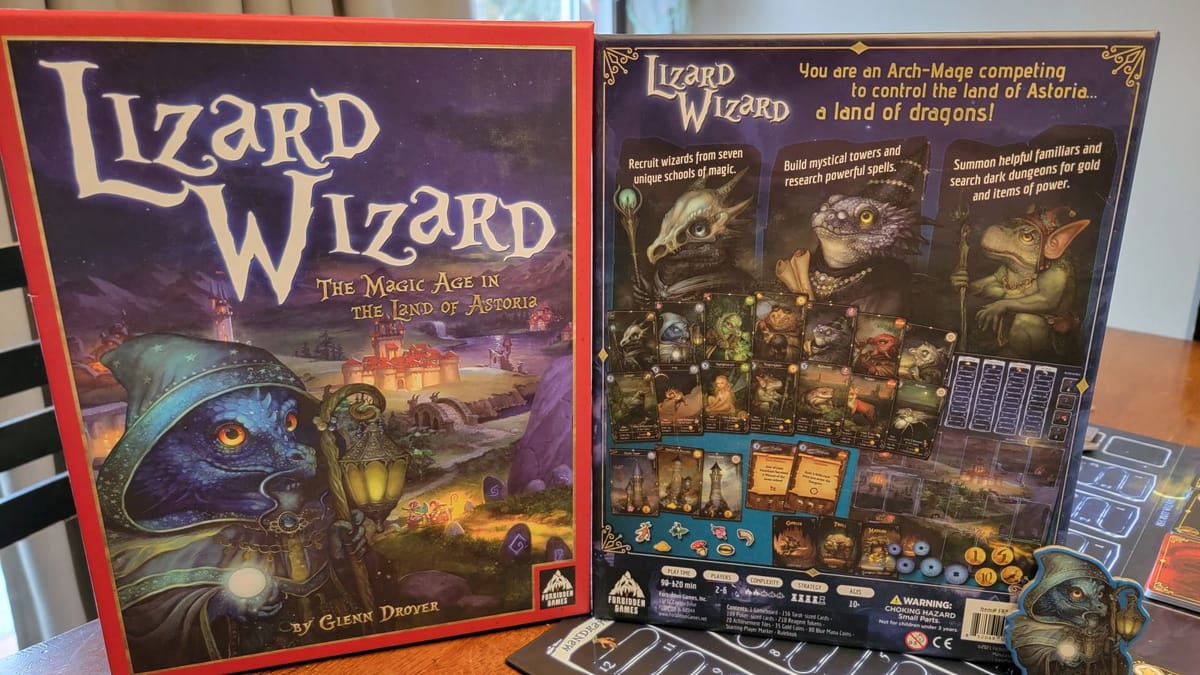
If you have ever had the desire to run your own economy in a board game there are more than a few options out there. One of the few offerings out there is Lizard Wizard, published by Forbidden Games and designed by Glenn Drover. Lizard Wizard comes in the standard Forbidden Games red box which makes it a little unassuming, but once you delve into the depths of the game and get to use the components, it is clear there are a smattering of components that offer a fantastic welcome into the fantasy world of Astoria. Lizard Wizard sees players as arch-mages vying for control of the land of Astoria.
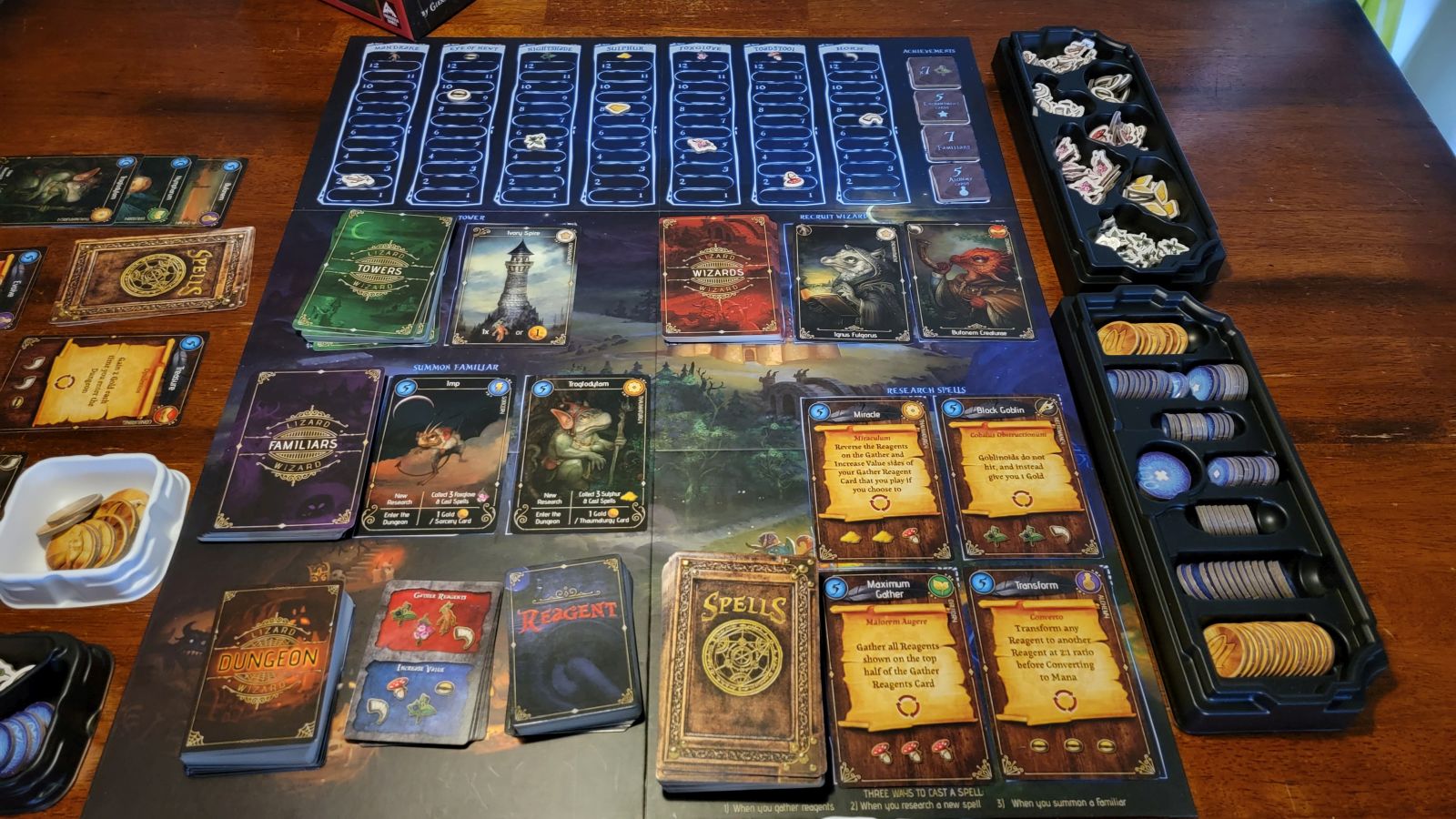
A game of Lizard Wizard puts players in a fantasy world of economics, wizardry, and a bit of world building. As an arch-mage that vies for control of Astoria, players will compete with each other to hire the most powerful mages, conjure powerful spells, construct wizard towers, and summon many familiars. The arch-mage that is able to accomplish this will rule Astoria. How does a player/arch-mage accomplish this? Well first there are many decks that are within the game that are the driving force for the main part of the game. There is the wizard deck, the reagents deck, the familiar deck, the spell deck, the tower deck, and the dungeon deck.
Each of these decks presents different ways that the game can end and be specialized/be played. The game ends when one of the familiar, wizard, spell, or tower decks is emptied, including face up cards. What does one of these decks being emptied entail? Well during the game each player takes a single action on their turn and play continues until the aforementioned emptying of one deck. There are six actions to choose from and those include gathering reagents, converting reagents to mana, recruiting wizards, researching spells, creating towers, and summoning a familiar.
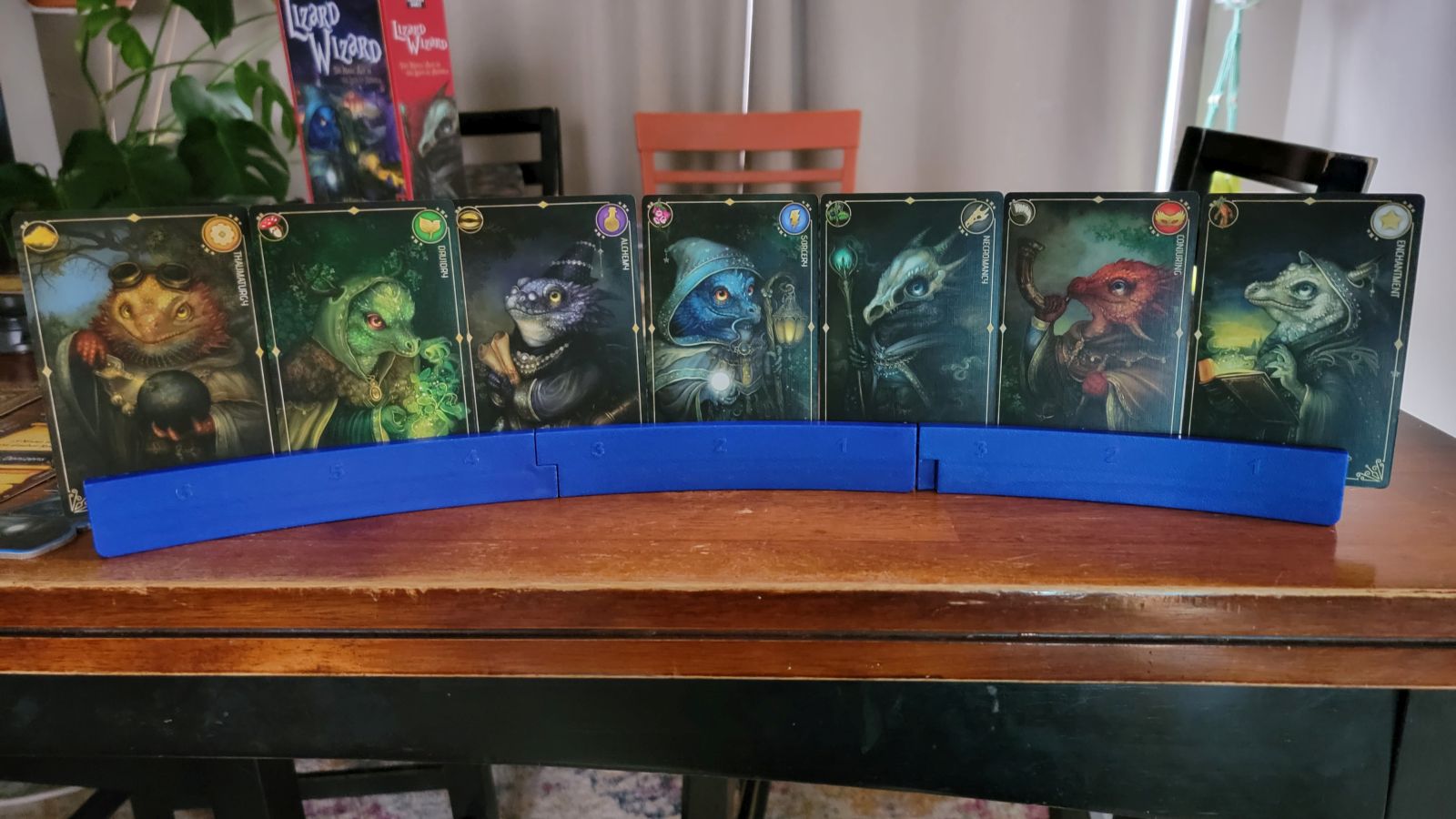
Within each of these actions is the basis for how you build your gathering of wizards and others. First and foremost each wizard has one of seven schools of magic that it excels at. These also correspond across familiars, towers, and spells. Sharing the schools of magic across the different cards in the game is one of the main parts of scoring towards the end of the game, and also strengthens each player’s board.
Gathering reagents uses reagent cards that each player receives throughout the game. These reagent cards have two purposes; one, to give players reagents based on the top half of the card to stockpile, up to their limit of 10 of course, and two, to further increase the value of the reagents based on the bottom half of the card. The value is paid out in the form of the second available action converting reagents to mana. During any of your turns you can freely exchange one type of reagent for the amount of mana that they are worth, i.e. 10 mushrooms worth 10 mana each gives the player 100 mana.
Following this are the recruit a wizard and research spell actions which use said mana. Here is where Lizard Wizard provides a unique and fun way to build their cabal of wizards. The active player chooses a wizard they would like out of the two available and then starts the bidding. Bidding to gain a wizard takes place until everyone has passed except the highest bidder. If the active player here is not the highest bidder then the active player chooses another wizard and play continues until the active player wins/gains a wizard. Wizards provide set collection bonuses with towers, spells, and familiars.
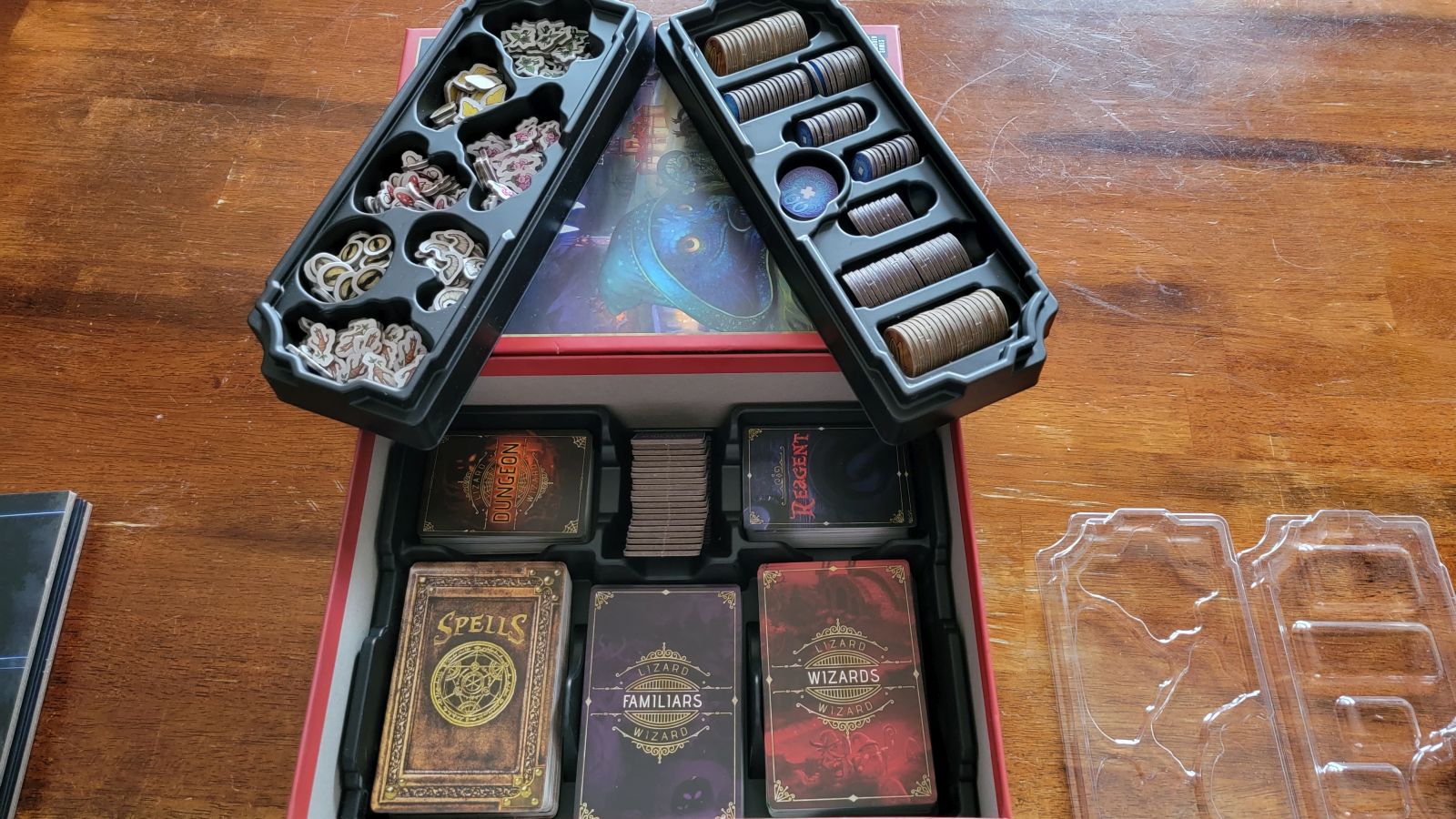
Researching a spell is the other big use of mana. Mana is used to cast spells that further add effects to your board, or can increase the amount of points, goods, and abilities players can have. Here is where players can match the schools of the spells with wizards and towers to score more points as the game progresses. Players also do not have to cast spells right away but can save them for later if there is a spell that provides a significant benefit you might not want other players to have. Reagents are also used in the casting of spells so managing reagents between their sale and uses is yet another tricky avenue players must navigate.
Towers require players to build them via gold or reagents based on the towers available. The towers provide increased storage for your reagents with each tower adding one to your total you can hold. They can also provide sets with your wizards and spells to score points at the end of the game. Familiars on the other hand are used for a few things but provide no scoring at the end of the game. Familiars cost mana as well and once bought provide one of four options to be used; gaining gold based on how many of that particular school of magic you have, gaining reagents shown on the familiar card, allowing players to research a new spell, and enter the dungeon.
The dungeon is the “push your luck” aspect of the game. This is where players keep going until they have encountered two monsters, each dealing a damage, in effort for them to gain treasures and goals. The majority of treasures at the end of the game will give players points, and gold is worth points as well as used for purchasing towers. However the more players delve into the dungeon the more dangerous it becomes as the treasures come out of the deck increasing the amount of monsters vs treasures and gold cards found in the deck.
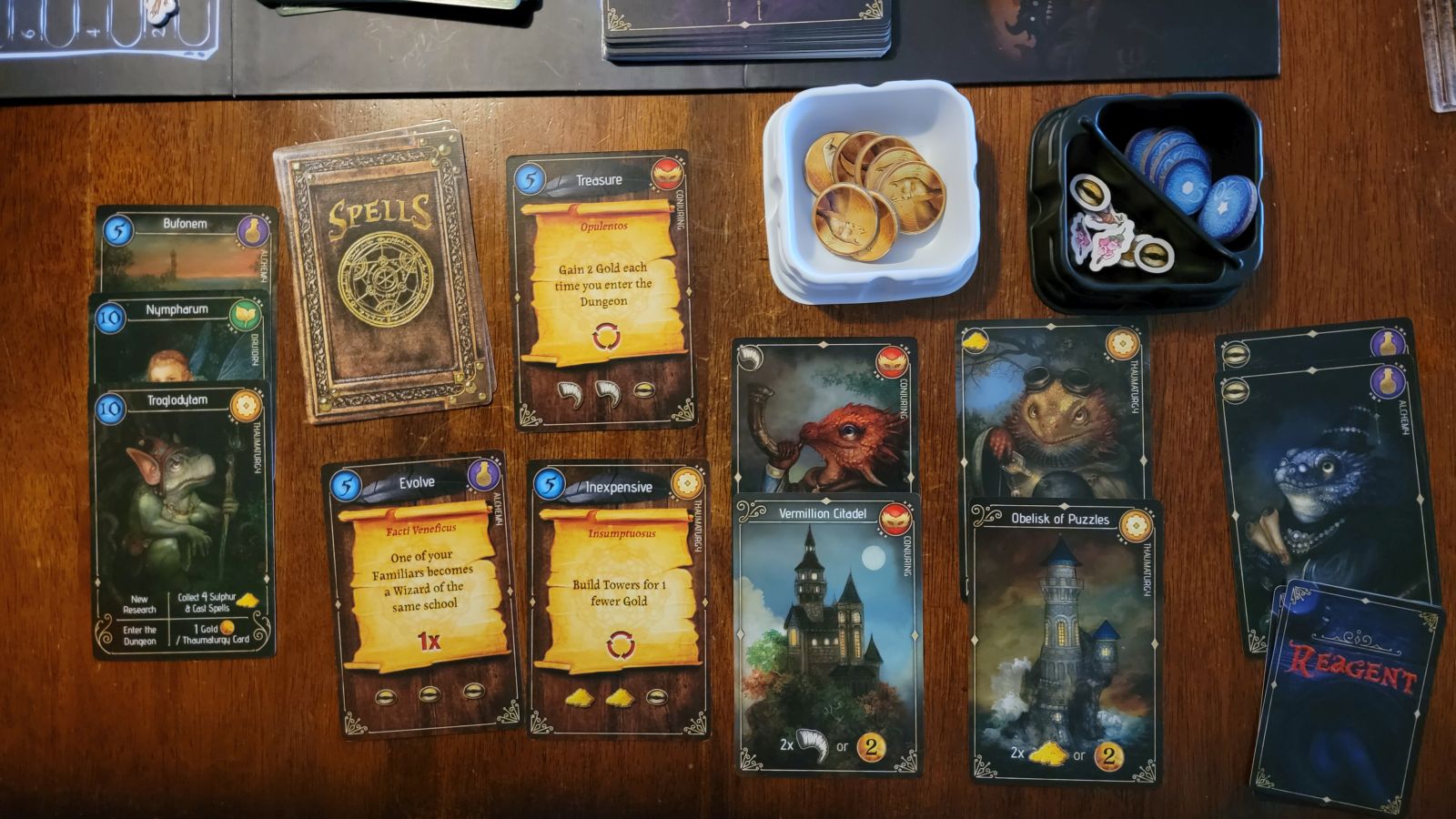
After a deck and face up market is empty and cleared, play continues until the end of the current round and then points are counted and the arch-mage that is the new ruler of Astoria is crowned.
Lizard Wizard benefits from a few different things and that is its diversity of actions you can take in a turn, the different avenues that players have in order to take such actions in turns, and ultimately great artwork and a well designed and interconnected game. The more I seemed to play the more I appreciated the game and its depth and excellent design. With enthralling art and fun pieces, not to mention custom trays that fit the pieces in the box and provide fantastic storage, Lizard Wizard is a game I aim to get to the table frequently.
Sometimes though with great power comes great responsibility and that comes in the form of how sometimes the game can drag on a bit long if players do not all participate in all aspects of the game and instead of one deck being the main action/deck that is gone through, players go through all decks evenly which can extend play time well past what it should be. The board also takes up a significant amount of real estate on the table meaning players are going to need a good amount of space to play the game. Lastly the rulebook has a couple of very minor tweaks; it could use some minor clarifications in order to make games run a little smoother.
Lizard Wizard
Great
In the grand scheme of things the board game landscape has been graced with the likes of Lizard Wizard. This means more wizards, more familiars, more towers and more spells. What more does anyone need to become the arch-mage of legend and rule Astoria? Nothing, the box provides a great gaming experience that anyone that gets their hands on a copy should be excited to play. Despite it taking an entire table's worth of playing space, Wizard Lizard has plenty of gifts that keep on giving, making it a premier economic game in any gamers collection.
Pros
- Lots of replayability between the smattering of different decks and components offered in the game
- Fantastic art and storage make the game aesthetically pleasing
- Storage makes ease of access to playing the game and putting the game away a breeze
Cons
- Lots of piece can be a bit daunting for the uninitiated
- Games have the potential to run longer than they should
- Table space can become an issue for those playing on smaller tables
